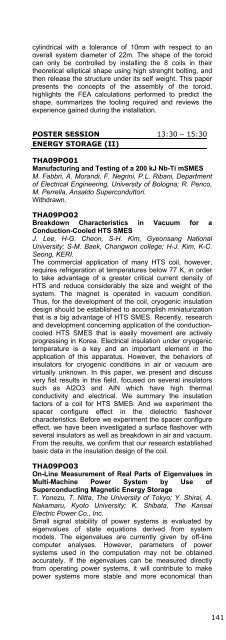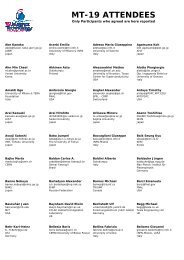Click here to download the abstract booklet in pdf format - MT19 - Infn
Click here to download the abstract booklet in pdf format - MT19 - Infn
Click here to download the abstract booklet in pdf format - MT19 - Infn
You also want an ePaper? Increase the reach of your titles
YUMPU automatically turns print PDFs into web optimized ePapers that Google loves.
cyl<strong>in</strong>drical with a <strong>to</strong>lerance of 10mm with respect <strong>to</strong> an<br />
overall system diameter of 22m. The shape of <strong>the</strong> <strong>to</strong>roid<br />
can only be controlled by <strong>in</strong>stall<strong>in</strong>g <strong>the</strong> 8 coils <strong>in</strong> <strong>the</strong>ir<br />
<strong>the</strong>oretical elliptical shape us<strong>in</strong>g high strenght bolt<strong>in</strong>g, and<br />
<strong>the</strong>n release <strong>the</strong> structure under its self weight. This paper<br />
presents <strong>the</strong> concepts of <strong>the</strong> assembly of <strong>the</strong> <strong>to</strong>roid,<br />
highlights <strong>the</strong> FEA calculations performed <strong>to</strong> predict <strong>the</strong><br />
shape, summarizes <strong>the</strong> <strong>to</strong>ol<strong>in</strong>g required and reviews <strong>the</strong><br />
experience ga<strong>in</strong>ed dur<strong>in</strong>g <strong>the</strong> <strong>in</strong>stallation.<br />
POSTER SESSION 13:30 – 15:30<br />
ENERGY STORAGE (II)<br />
THA09PO01<br />
Manufactur<strong>in</strong>g and Test<strong>in</strong>g of a 200 kJ Nb-Ti mSMES<br />
M. Fabbri, A. Morandi, F. Negr<strong>in</strong>i, P.L. Ribani, Department<br />
of Electrical Eng<strong>in</strong>eer<strong>in</strong>g, University of Bologna; R. Penco,<br />
M. Perrella, Ansaldo Supercondut<strong>to</strong>ri.<br />
Withdrawn.<br />
THA09PO02<br />
Breakdown Characteristics <strong>in</strong> Vacuum for a<br />
Conduction-Cooled HTS SMES<br />
J. Lee, H-G. Cheon, S-H. Kim, Gyeonsang National<br />
University; S-M. Baek, Changwon college; H-J. Kim, K-C.<br />
Seong, KERI.<br />
The commercial application of many HTS coil, however,<br />
requires refrigeration at temperatures below 77 K, <strong>in</strong> order<br />
<strong>to</strong> take advantage of a greater critical current density of<br />
HTS and reduce considerably <strong>the</strong> size and weight of <strong>the</strong><br />
system. The magnet is operated <strong>in</strong> vacuum condition.<br />
Thus, for <strong>the</strong> development of <strong>the</strong> coil, cryogenic <strong>in</strong>sulation<br />
design should be established <strong>to</strong> accomplish m<strong>in</strong>iaturization<br />
that is a big advantage of HTS SMES. Recently, research<br />
and development concern<strong>in</strong>g application of <strong>the</strong> conductioncooled<br />
HTS SMES that is easily movement are actively<br />
progress<strong>in</strong>g <strong>in</strong> Korea. Electrical <strong>in</strong>sulation under cryogenic<br />
temperature is a key and an important element <strong>in</strong> <strong>the</strong><br />
application of this apparatus. However, <strong>the</strong> behaviors of<br />
<strong>in</strong>sula<strong>to</strong>rs for cryogenic conditions <strong>in</strong> air or vacuum are<br />
virtually unknown. In this paper, we present and discuss<br />
very fist results <strong>in</strong> this field, focused on several <strong>in</strong>sula<strong>to</strong>rs<br />
such as Al2O3 and AIN which have high <strong>the</strong>rmal<br />
conductivity and electrical. We summary <strong>the</strong> <strong>in</strong>sulation<br />
fac<strong>to</strong>rs of a coil for HTS SMES. And we experiment <strong>the</strong><br />
spacer configure effect <strong>in</strong> <strong>the</strong> dielectric flashover<br />
characteristics. Before we experiment <strong>the</strong> spacer configure<br />
effect, we have been <strong>in</strong>vestigated a surface flashover with<br />
several <strong>in</strong>sula<strong>to</strong>rs as well as breakdown <strong>in</strong> air and vacuum.<br />
From <strong>the</strong> results, we confirm that our research established<br />
basic data <strong>in</strong> <strong>the</strong> <strong>in</strong>sulation design of <strong>the</strong> coil.<br />
THA09PO03<br />
On-L<strong>in</strong>e Measurement of Real Parts of Eigenvalues <strong>in</strong><br />
Multi-Mach<strong>in</strong>e Power System by Use of<br />
Superconduct<strong>in</strong>g Magnetic Energy S<strong>to</strong>rage<br />
T. Yonezu, T. Nitta, The University of Tokyo; Y. Shirai, A.<br />
Nakamaru, Kyo<strong>to</strong> University; K. Shibata, The Kansai<br />
Electric Power Co., Inc.<br />
Small signal stability of power systems is evaluated by<br />
eigenvalues of state equations derived from system<br />
models. The eigenvalues are currently given by off-l<strong>in</strong>e<br />
computer analyses. However, parameters of power<br />
systems used <strong>in</strong> <strong>the</strong> computation may not be obta<strong>in</strong>ed<br />
accurately. If <strong>the</strong> eigenvalues can be measured directly<br />
from operat<strong>in</strong>g power systems, it will contribute <strong>to</strong> make<br />
power systems more stable and more economical than<br />
<strong>the</strong>y are now. T<strong>here</strong>fore, on-l<strong>in</strong>e measurement of <strong>the</strong><br />
eigenvalues by use of Superconduct<strong>in</strong>g Magnetic Energy<br />
S<strong>to</strong>rage (SMES) has been proposed. The eigenvalues of<br />
power systems can be measured by analyz<strong>in</strong>g <strong>the</strong> output<br />
power of genera<strong>to</strong>rs and transmission l<strong>in</strong>es for small power<br />
changes generated by SMES. It can give small power<br />
changes without affect<strong>in</strong>g operat<strong>in</strong>g conditions of <strong>the</strong> power<br />
systems. For <strong>the</strong> waveforms of power changes from<br />
SMES, s<strong>in</strong>usoidal signals and chirp signals have been<br />
studied. In case of s<strong>in</strong>usoidal signals, <strong>the</strong> imag<strong>in</strong>ary parts<br />
of <strong>the</strong> eigenvalues can be measured <strong>in</strong> any power systems.<br />
However, <strong>the</strong> real parts of <strong>the</strong>m can be measured only <strong>in</strong><br />
one-mach<strong>in</strong>e <strong>in</strong>f<strong>in</strong>ite bus system. A new method us<strong>in</strong>g<br />
power change of s<strong>in</strong>usoidal waveform for measurement of<br />
<strong>the</strong> real parts of <strong>the</strong> eigenvalues of multi-mach<strong>in</strong>e power<br />
system will be described <strong>in</strong> <strong>the</strong> paper. Some simulations<br />
were carried out <strong>in</strong> order <strong>to</strong> exam<strong>in</strong>e <strong>the</strong> method by use of<br />
analogue type power system simula<strong>to</strong>rs. The results of<br />
simulations will be also described.<br />
THA09PO04<br />
Design of HTS Magnets for a 600 kJ SMES<br />
W-S. Kim, S. Lee, S-Y. Hahn, Korea Electrical Eng<strong>in</strong>eer<strong>in</strong>g<br />
and Science Research Institute; S-Y. Kwak, H-K. Jung,<br />
Seoul National University; K-D. Choi, J-H. Han, Korea<br />
Polytechnic University; J-K. Lee, Woosuk University; K-C.<br />
Seong, Korea Electrotechnology Research Institute.<br />
Development of a 600 kJ SMES system is <strong>in</strong> progress by<br />
Korean Electric Research Institute (KERI). High<br />
temperature superconduct<strong>in</strong>g wires are go<strong>in</strong>g <strong>to</strong> be used<br />
for <strong>the</strong> w<strong>in</strong>d<strong>in</strong>gs of <strong>the</strong> system, and <strong>the</strong> design of <strong>the</strong> HTS<br />
w<strong>in</strong>d<strong>in</strong>gs for <strong>the</strong> system is presented <strong>in</strong> this paper. We<br />
considered BSCCO-2212 wire for <strong>the</strong> HTS w<strong>in</strong>d<strong>in</strong>gs which<br />
is preferred <strong>in</strong> lower temperature environment <strong>to</strong> BSCCO-<br />
2223 wire. The operat<strong>in</strong>g temperature of <strong>the</strong> w<strong>in</strong>d<strong>in</strong>g was<br />
decided <strong>to</strong> be 20K which will be accomplished by<br />
conduction cool<strong>in</strong>g method us<strong>in</strong>g cryo-coolers. Four<br />
stacked BSCCO-2212 wire were used for design process<br />
of <strong>the</strong> HTS w<strong>in</strong>d<strong>in</strong>gs, and <strong>the</strong> objective function of <strong>the</strong><br />
optimal process was <strong>the</strong> <strong>to</strong>tal amount of <strong>the</strong> HTS wire. This<br />
HTS w<strong>in</strong>d<strong>in</strong>gs is go<strong>in</strong>g <strong>to</strong> be applied <strong>to</strong> <strong>the</strong> SMES system<br />
whose purpose is stabilization of <strong>the</strong> power grid.<br />
THA09PO05<br />
Design study of a 54MJ class magnet of a SMES for<br />
Power System Stabilization<br />
H. Hayashi, T. Nagafuchi, Kyushu Electric Power Co., Inc.;<br />
S. Okitsu, K. Takeuchi, Hitachi Ltd.<br />
We have developed a SMES system for power system<br />
stabilization, aim<strong>in</strong>g at reduc<strong>in</strong>g <strong>the</strong> costs of <strong>the</strong> system.<br />
The multi-pole solenoid coils of Bi2212 conduc<strong>to</strong>r for <strong>the</strong><br />
100MW/54MJ class SMES was designed with <strong>the</strong> rated<br />
current of 3kA and maximum magnetic field of 10T. Our<br />
study revealed that <strong>the</strong> maximum magnetic field applied <strong>to</strong><br />
<strong>the</strong> magnet is effective <strong>to</strong> reduce <strong>the</strong> magnet size and<br />
volume, and <strong>in</strong> terms of magnetic stress applied <strong>to</strong> <strong>the</strong><br />
Bi2212 conduc<strong>to</strong>r and <strong>the</strong> support structure. The AC loss<br />
ma<strong>in</strong>ly depend<strong>in</strong>g on histeresis loss was also calculated.<br />
Thus, <strong>the</strong> authors confirmed <strong>the</strong> possibility of 54MJ class<br />
SMES’s magnet for power system stabilization <strong>in</strong> a power<br />
system.<br />
THA09PO06<br />
Heat transfer properties of a conduction cooled<br />
pro<strong>to</strong>type LTS pulse coil for UPS-SMES<br />
A. Kawagoe, H. Yamamuro, F. Sumiyoshi, Kagoshima<br />
University; T. Mi<strong>to</strong>, H. Chikaraishi, T. Baba, NIFS; T.<br />
Henmi, Gradient University for Advanced Studies; K.<br />
Okumura, R. Abe, Technova Inc.; M. Iwakuma, Kyushu<br />
141 MT-19 2005, Genova



